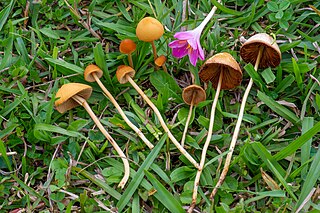
Conocybe is a genus of mushrooms with Conocybe tenera as the type species and at least 243 other species. There are at least 50 different species in North America.
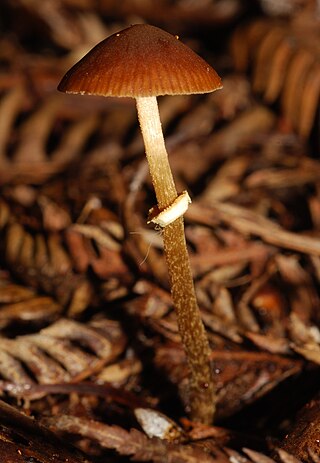
Conocybe rugosa is a common species of mushroom that is widely distributed and especially common in the Pacific Northwest of the United States. It grows in woodchips, flowerbeds and compost. It has been found in Europe, Asia and North America. It contains the same mycotoxins as the death cap mushroom. Conocybe rugosa was originally described in the genus Pholiotina, and its morphology and a 2013 molecular phylogenetics study supported its continued classification there.

Conocybe tenera, commonly known as the brown dunce cap or common cone head, is a widely distributed member of the genus Conocybe. This mushroom is the type species for the genus Conocybe.

Pholiotina cyanopus is a species of fungus that contains psychoactive compounds including psilocybin and the uncommon aeruginascin. Originally described as Galerula cyanopus by American mycologist George Francis Atkinson in 1918. It was transferred to Conocybe by Robert Kühner in 1935 before being transferred to Pholiotina by Rolf Singer in 1950. A 2013 molecular phylogenetics study found it to belong to a group of species currently assigned to Pholiotina that are more closely related to Galerella nigeriensis than to Pholiotina or Conocybe. It is likely that it will be moved to a different genus in the future, but this has not happened yet.
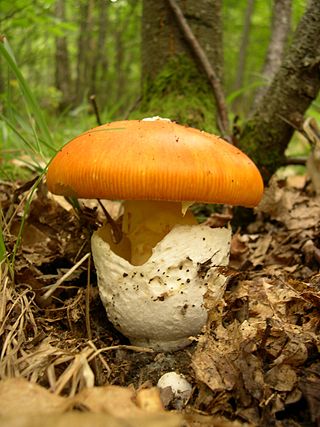
In mycology, a volva is a cup-like structure at the base of a mushroom that is a remnant of the universal veil, or the remains of the peridium that encloses the immature fruit bodies of gasteroid fungi. This macrofeature is important in wild mushroom identification because it is an easily observed, taxonomically significant feature that frequently signifies a member of Amanitaceae. This has particular importance due to the disproportionately high number of deadly poisonous species contained within that family.
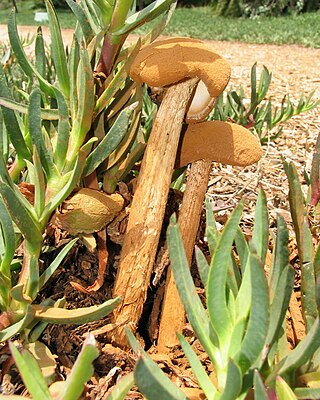
Battarrea phalloides is an inedible species of mushroom in the family Agaricaceae, and the type species of the genus Battarrea. Known in the vernacular as the scaley-stalked puffball, sandy stiltball, or desert stalked puffball, it has a woody, slender, and shaggy or scaly stem that is typically up to 40 centimeters (15.7 in) in length. Although its general appearance resembles an agaric with stem and gills, atop the stem is a spore sac, consisting of a peridium and a powdery internal gleba. In maturity, the spore sac ruptures to release the spores. Battarrea phalloides is found in dry, sandy locations throughout the world, and has been collected from Africa, Asia, Australia, Europe, North America, and South America. There is currently some disagreement in the literature as to whether the European B. stevensii is the same species as B. phalloides.
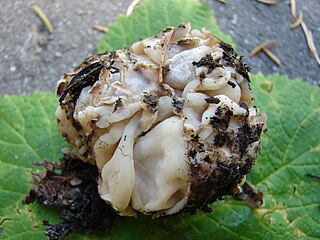
Geopora cooperi, commonly known as the pine truffle or the fuzzy truffle, is a species of fungus in the family Pyronemataceae. It has a fuzzy brown outer surface and an inner surface of whitish, convoluted folds of tissue. Widely distributed in the Northern Hemisphere, the species has been recorded from Asia, Europe, and North America.

Leccinum arenicola is a species of bolete mushroom in the family Boletaceae. Described in 1979, the fruit bodies (mushrooms) grow in sand dunes from New Brunswick south to Cape Cod.

Conocybe aurea is a basidiomycete fungus in the family Bolbitiaceae.
Conocybe moseri is a mushroom species in the family Bolbitiaceae. It was described as new to science in 1980 by mycologist Roy Watling, from collections made in France. The specific epithet moseri honours Austrian mycologist Meinhard Moser. The fungus has been reported from the United Kingdom, growing in grassy areas, fields, and edges of woods. In 1995, it was recorded from Switzerland, from Ukraine in 2007, and from Russia in 2007. It was reported from India in 2015, where it was found growing on cattle dung.

Conocybe macrospora is a species of mushroom-producing fungus in the family Bolbitiaceae.
Conocybe anthuriae is a species of mushroom-producing fungus in the family Bolbitiaceae.
Conocybe volvata is a species of mushroom-producing fungus in the family Bolbitiaceae.
Conocybe corneri is a species of mushroom-producing fungus in the family Bolbitiaceae.
Conocybe vaginata is a species of mushroom-producing fungus in the family Bolbitiaceae.
Conocybe volviornata is a species of mushroom-producing fungus in the family Bolbitiaceae.
Conocybe crispella is a species of mushroom-producing fungus in the family Bolbitiaceae.

Conocybe mesospora is a species of mushroom-producing fungus in the family Bolbitiaceae.
Conocybe subxerophytica is a species of mushroom-producing fungus in the family Bolbitiaceae.
Conocybe subpallida is a species of mushroom-producing fungus in the family Bolbitiaceae.









